Mianzhi Liu
Boundary-Guided Trajectory Prediction for Road Aware and Physically Feasible Autonomous Driving
May 10, 2025Abstract:Accurate prediction of surrounding road users' trajectories is essential for safe and efficient autonomous driving. While deep learning models have improved performance, challenges remain in preventing off-road predictions and ensuring kinematic feasibility. Existing methods incorporate road-awareness modules and enforce kinematic constraints but lack plausibility guarantees and often introduce trade-offs in complexity and flexibility. This paper proposes a novel framework that formulates trajectory prediction as a constrained regression guided by permissible driving directions and their boundaries. Using the agent's current state and an HD map, our approach defines the valid boundaries and ensures on-road predictions by training the network to learn superimposed paths between left and right boundary polylines. To guarantee feasibility, the model predicts acceleration profiles that determine the vehicle's travel distance along these paths while adhering to kinematic constraints. We evaluate our approach on the Argoverse-2 dataset against the HPTR baseline. Our approach shows a slight decrease in benchmark metrics compared to HPTR but notably improves final displacement error and eliminates infeasible trajectories. Moreover, the proposed approach has superior generalization to less prevalent maneuvers and unseen out-of-distribution scenarios, reducing the off-road rate under adversarial attacks from 66\% to just 1\%. These results highlight the effectiveness of our approach in generating feasible and robust predictions.
PRTGS: Precomputed Radiance Transfer of Gaussian Splats for Real-Time High-Quality Relighting
Aug 07, 2024Abstract:We proposed Precomputed RadianceTransfer of GaussianSplats (PRTGS), a real-time high-quality relighting method for Gaussian splats in low-frequency lighting environments that captures soft shadows and interreflections by precomputing 3D Gaussian splats' radiance transfer. Existing studies have demonstrated that 3D Gaussian splatting (3DGS) outperforms neural fields' efficiency for dynamic lighting scenarios. However, the current relighting method based on 3DGS still struggles to compute high-quality shadow and indirect illumination in real time for dynamic light, leading to unrealistic rendering results. We solve this problem by precomputing the expensive transport simulations required for complex transfer functions like shadowing, the resulting transfer functions are represented as dense sets of vectors or matrices for every Gaussian splat. We introduce distinct precomputing methods tailored for training and rendering stages, along with unique ray tracing and indirect lighting precomputation techniques for 3D Gaussian splats to accelerate training speed and compute accurate indirect lighting related to environment light. Experimental analyses demonstrate that our approach achieves state-of-the-art visual quality while maintaining competitive training times and allows high-quality real-time (30+ fps) relighting for dynamic light and relatively complex scenes at 1080p resolution.
Spike-NeRF: Neural Radiance Field Based On Spike Camera
Mar 25, 2024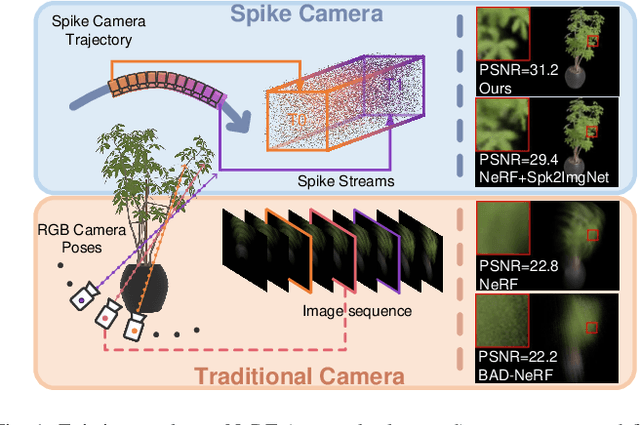
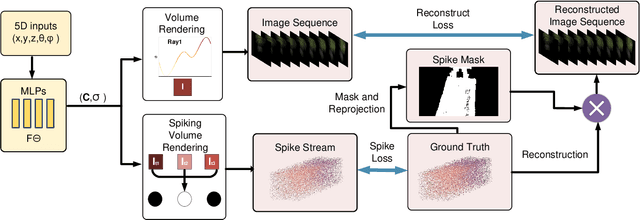
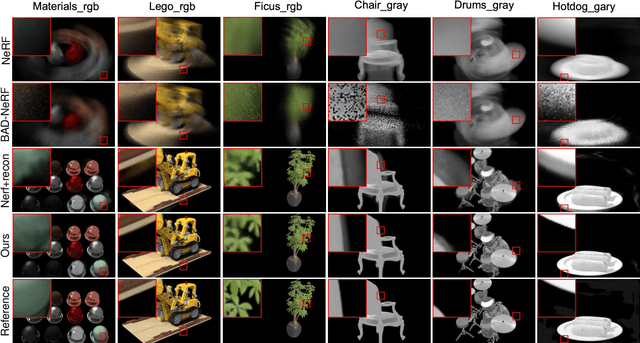
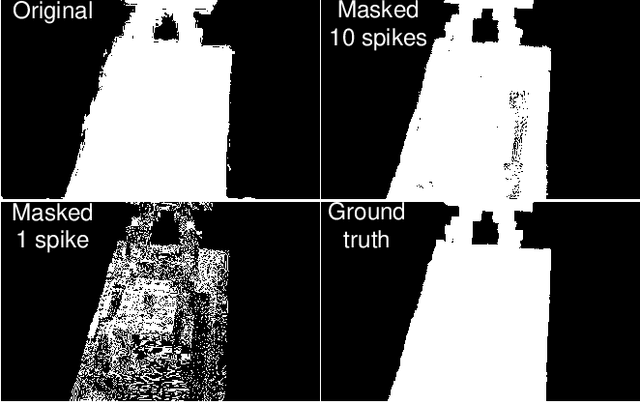
Abstract:As a neuromorphic sensor with high temporal resolution, spike cameras offer notable advantages over traditional cameras in high-speed vision applications such as high-speed optical estimation, depth estimation, and object tracking. Inspired by the success of the spike camera, we proposed Spike-NeRF, the first Neural Radiance Field derived from spike data, to achieve 3D reconstruction and novel viewpoint synthesis of high-speed scenes. Instead of the multi-view images at the same time of NeRF, the inputs of Spike-NeRF are continuous spike streams captured by a moving spike camera in a very short time. To reconstruct a correct and stable 3D scene from high-frequency but unstable spike data, we devised spike masks along with a distinctive loss function. We evaluate our method qualitatively and numerically on several challenging synthetic scenes generated by blender with the spike camera simulator. Our results demonstrate that Spike-NeRF produces more visually appealing results than the existing methods and the baseline we proposed in high-speed scenes. Our code and data will be released soon.
Learning to Robustly Reconstruct Low-light Dynamic Scenes from Spike Streams
Jan 19, 2024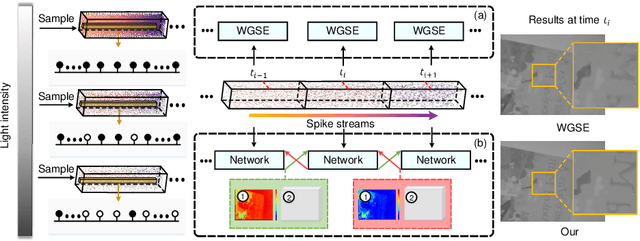


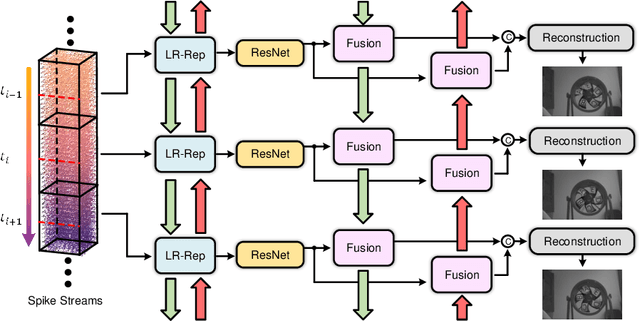
Abstract:As a neuromorphic sensor with high temporal resolution, spike camera can generate continuous binary spike streams to capture per-pixel light intensity. We can use reconstruction methods to restore scene details in high-speed scenarios. However, due to limited information in spike streams, low-light scenes are difficult to effectively reconstruct. In this paper, we propose a bidirectional recurrent-based reconstruction framework, including a Light-Robust Representation (LR-Rep) and a fusion module, to better handle such extreme conditions. LR-Rep is designed to aggregate temporal information in spike streams, and a fusion module is utilized to extract temporal features. Additionally, we have developed a reconstruction benchmark for high-speed low-light scenes. Light sources in the scenes are carefully aligned to real-world conditions. Experimental results demonstrate the superiority of our method, which also generalizes well to real spike streams. Related codes and proposed datasets will be released after publication.
 Add to Chrome
Add to Chrome Add to Firefox
Add to Firefox Add to Edge
Add to Edge